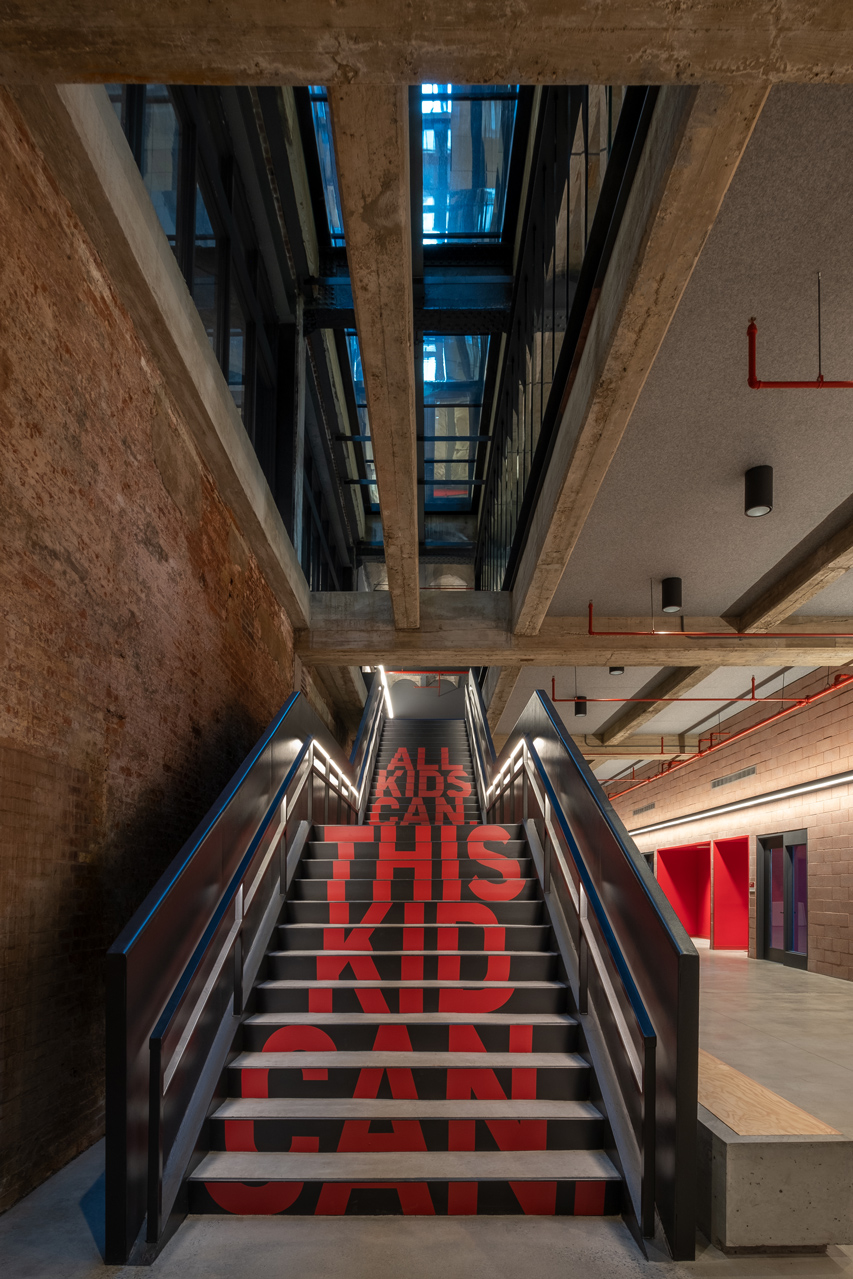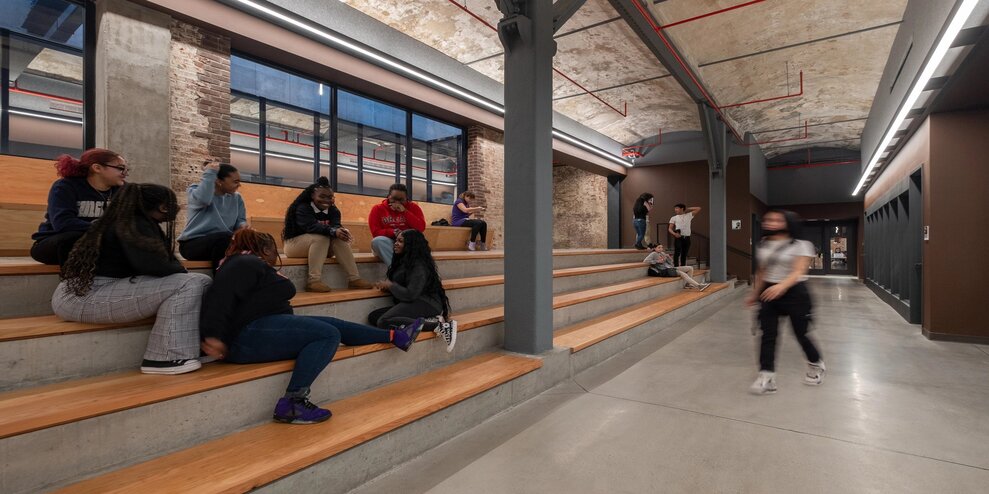Architect David Adjaye’s first school building turned an abandoned ice factory into a cathedral of learning.
A hulking 120-year-old brick building on the shore of the Harlem River in the South Bronx was once a centerpiece of the New York City economy. Its original life as an ice factory and warehouse supported beer brewers in the growing metropolis and helped supply the wealth that built nearby Yankee Stadium. But it eventually became a shell, abandoned for 40 years and occupied only by a family of goats that had taken over the ground floor. For many residents in recent years, the empty building was little more than a massive and absurd base for a humongous billboard advertising the ridesharing company Uber.
Now, the building has been given a new life. With an adaptive reuse design by celebrated Ghanaian British architect David Adjaye, this former factory has become what may be the most striking public school in the United States.
![[Photo: James Wang Images/Adjaye Associates]](https://wp-cms-fastcompany-com.s3.amazonaws.com/uploads/2023/05/01-90890683-factory-school-conversion.jpg)
The building, known as 20 Bruckner, is now home to the Dream Charter School, the latest location of New York City public charter schools operated by Dream, a 30-year-old nonprofit focused on educating underserved youth communities in East Harlem and the South Bronx. Intended to accommodate 1,300 students in pre-K through 12th grade, the school started with classes for high school students in January.![[Photo: James Wang Images/Adjaye Associates]](https://wp-cms-fastcompany-com.s3.amazonaws.com/uploads/2023/05/02-90890683-factory-school-conversion.jpg) [Photo: James Wang Images/Adjaye Associates]
[Photo: James Wang Images/Adjaye Associates]
Looking like no school they’d ever seen before, the interior features barrel-vaulted ceilings and exposed bricks and steel beams, with modern classrooms, hallways, and gathering spaces tucked within. Huge windows line the classrooms, and large kaleidoscopic light wells bring daylight into the nearly 200,000-square-foot space. One remnant of the building’s original function is a 70-foot-high room that once held the ice factory’s works, which Adjaye preserved intact and turned into an unexpectedly light-drenched social space the school has dubbed, Hall of Dreams. [Photos: James Wang Images/Adjaye Associates]
[Photos: James Wang Images/Adjaye Associates]

“There was something really compelling to me about this space, from its double height to the exposed steel beams and red brick,” Adjaye writes via email. “The height allowed for a cathedral-like space, which fits with the idea of a school as a temple of knowledge, freedom of thought, and the uncapped potential of the students.”
Adjaye’s firm, Adjaye Associates, is known for its striking, inventive, and mostly high-end buildings, such as the Smithsonian’s National Museum of African American History and Culture in Washington, D.C., 20 Bruckner is the firm’s first school design, a fact that didn’t dissuade Dream from seeking Adjaye’s services. The raw bones of the building, and its decades-old state of dishevelment, called for a radical intervention.![[Photo: James Wang Images/Adjaye Associates]](https://wp-cms-fastcompany-com.s3.amazonaws.com/uploads/2023/05/11-90890683-factory-school-conversion.jpg) [Photo: James Wang Images/Adjaye Associates]
[Photo: James Wang Images/Adjaye Associates]
“The first time I saw it, it yelled run away,” says Richard Berlin, Dream’s co-CEO. “It hadn’t been touched in 40 years at that point. There were holes on the floors, holes in the wall.” The building had neither electricity or water, but plenty of goats. The building’s owner later invested in some basic interior fixes that Berlin refers to as “white-boxing,” opening up the possibility of it working as a site for Dream’s growing public school footprint. The organization signed a lease in June 2019 and brought Adjaye in to lead the transformation.
Much about the building—a dark factory—had to be changed to house a school. But Berlin says the industrial nature of the building had some surprising upsides once Adjaye’s firm had a chance to dig in. “There’s so much structural steel in the building that I was really worried the building would get inefficient fast because there’d be giant columns in the middle of every classroom,” he says. “But the column structure actually creates perfect 800 square foot rectangles all around the perimeter of the building, and that’s about the size of a Dream classroom.”![[Photo: James Wang Images/Adjaye Associates]](https://wp-cms-fastcompany-com.s3.amazonaws.com/uploads/2023/05/09-90890683-factory-school-conversion.jpg) [Photo: James Wang Images/Adjaye Associates]
[Photo: James Wang Images/Adjaye Associates]
Deeper inside, Adjaye’s firm carved out the other requisite school spaces, like a gym and a cafeteria, and sliced two large wells through the upper portions of the building to illuminate the core. Mirrored glass on the sides of those wells help reflect and spread the light while also creating a stunning overhead visual display. “We wanted the school to feel more like a light-filled laboratory where learning, exploration, and experimentation can happen in and outside of the classroom,” Adjaye says.![[Photo: James Wang Images/Adjaye Associates]](https://wp-cms-fastcompany-com.s3.amazonaws.com/uploads/2023/05/15-90890683-factory-school-conversion.jpg) [Photo: James Wang Images/Adjaye Associates]
[Photo: James Wang Images/Adjaye Associates]
The project does have some troubling history that can only be partly separated from its remarkable transformation. On separate occasions, dating back to 2018, three laborers died while doing work on the building; two of the accidents occurred after Dream signed its lease, and lawsuits are pending against the building owner’s organization.
The building’s redesign cost about $50 million, which was all raised by Dream. Berlin says the price tag and the world-class design are necessary parts of the way Dream aims to upend public education in its target neighborhoods. “There are less expensive and more expensive versions; but no matter what, no matter where, it is New York City real estate. So if you want a high-functioning space for kids, you’re going to end up spending a lot of time and money and effort,” he says. “The majority of New York City public school buildings look much more like a prison than a place of higher learning.”![[Photo: James Wang Images/Adjaye Associates]](https://wp-cms-fastcompany-com.s3.amazonaws.com/uploads/2023/05/06-90890683-factory-school-conversion.jpg) [Photo: James Wang Images/Adjaye Associates]
[Photo: James Wang Images/Adjaye Associates]
Dream has tried to offer another model with its roster of seven schools, all covering pre-K through 12th grade. One standout is a combined elementary school and middle school in East Harlem, which was developed alongside an 11-story subsidized-housing project and a public park, turning the school into a connecting thread for the community. “We really believe that place does a lot of work,” Berlin adds.![[Photo: James Wang Images/Adjaye Associates]](https://wp-cms-fastcompany-com.s3.amazonaws.com/uploads/2023/05/14-90890683-factory-school-conversion.jpg) [Photo: James Wang Images/Adjaye Associates]
[Photo: James Wang Images/Adjaye Associates]
Adjaye’s design is intended to make the building work for Dream’s growing educational ambitions, but also to rewrite the often bleak playbook of public school design. “I am enchanted by this idea of storage spaces and warehouses becoming active sites of learning and think there is untapped potential in these structures for educating future generations,” Adjaye says. “I think Dream establishes a precedent, which I hope more and more cities adopt, which is about recognizing the value of often abandoned or considered derelict industrial buildings. These spaces can very much serve as a functional canvas for 21st century learning.”
—
This article first appeared in https://www.fastcompany.com
Seeking to build and grow your brand using the force of consumer insight, strategic foresight, creative disruption and technology prowess? Talk to us at +971 50 6254340 or engage@groupisd.com or visit www.groupisd.com/story

